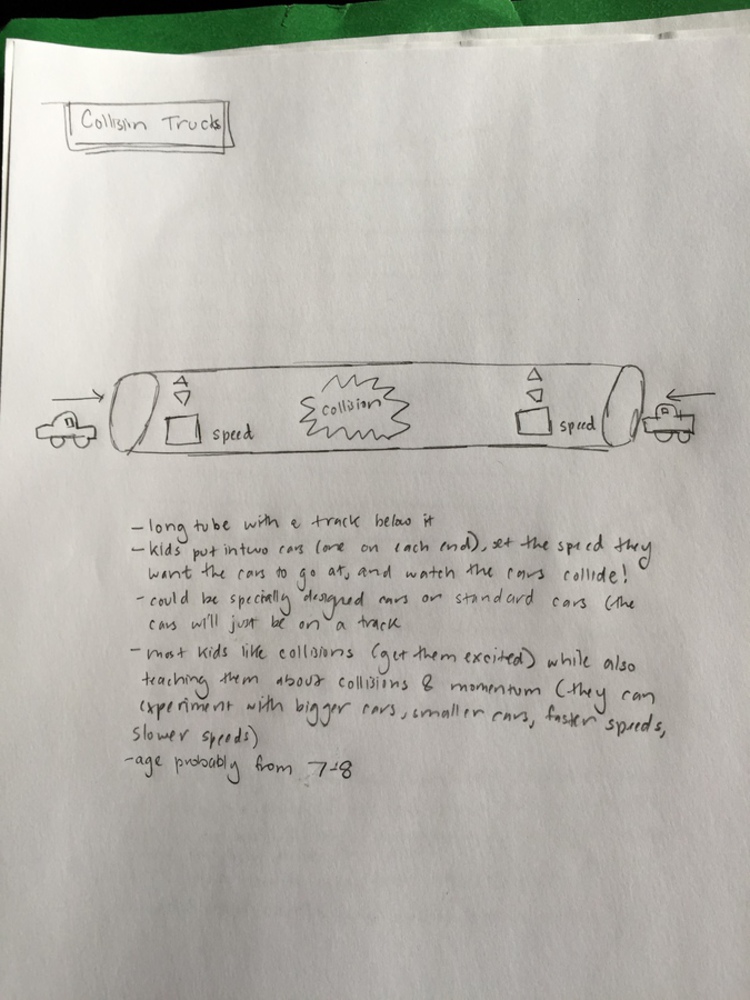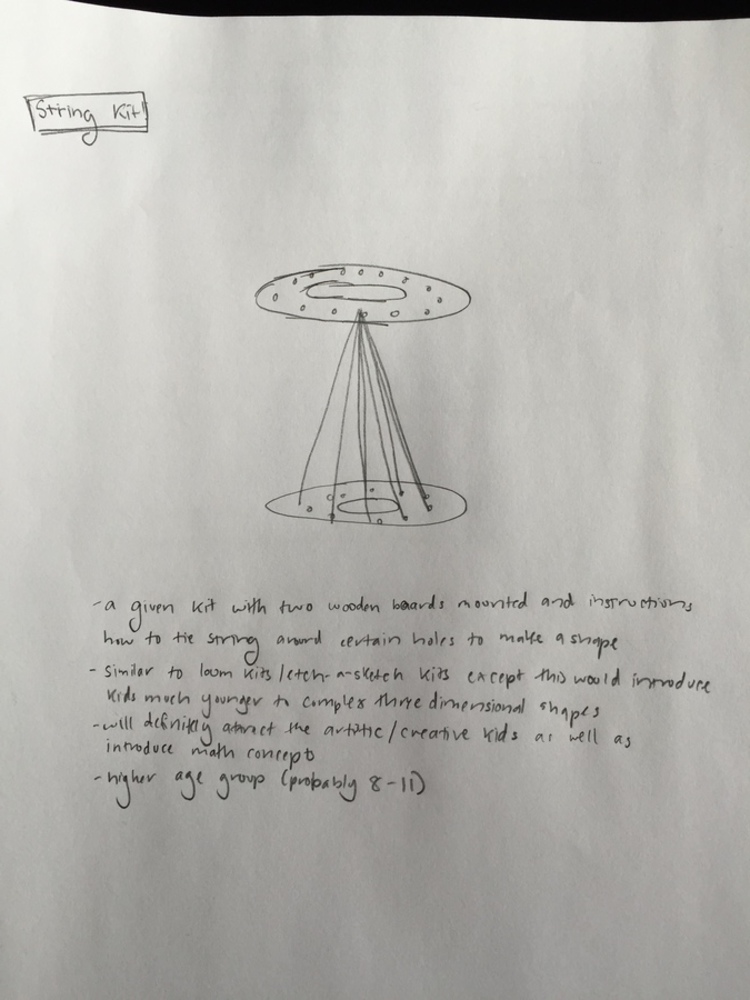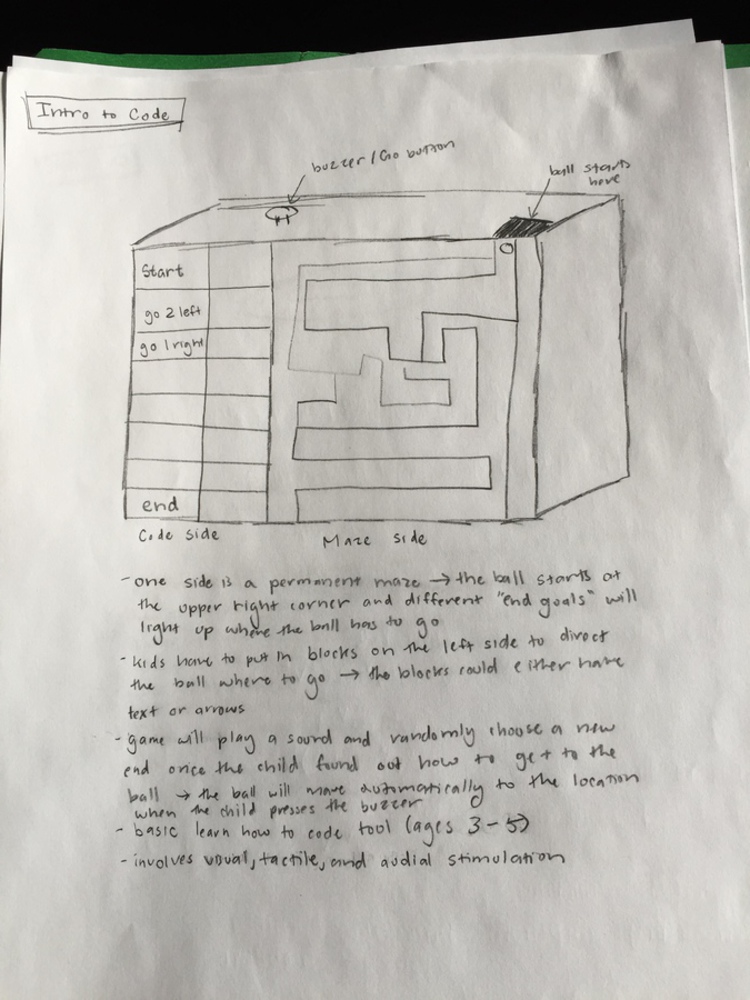Outcome
Product
Collision Trucks: Put a toy car/truck in to either side of the tube, set what speed you want the trucks to go at, and watch them collide! Teaches children about the basics of momentum and collisions.
String Kit: Given a set of wooden preassembled parts and string, use instructions on how to tie string around the assembly to make cool shapes! Teaches kids about more complex three dimensional shapes/helps them learn how to visualize 3D shapes in their mind earlier.
Intro-to-Code: Have kids place blocks in order in the machine to move a ball through a maze to a given end point! Have levels to introduce more complex levels of coding structures (for loops, while loops, even recursion!).
Collision Trucks:
1) the principle your toy is based on: The main principle that I wanted children to take away from this toy was of momentum (with a little bit extra of collisions - maybe elastic/inelastic).
2) how will the child interact with the toy: The child will simply put in two trucks in the ends of the tube, set the speed for the trucks, and then watch them crash! The machine will then spit out the trucks at the end of the collision.
3) construction cost, durability, safety: I think the construction cost will be in the $35-40 dollar range, as there will need to be one main rail, two motors, one main control board, and then aesthetic cover ups. Thus this toy will definitely be in the more expensive range (retailing at about $90-$100 dollars). Durability shouldn't really be an issue, besides for the toy cars, but toy cars are rather inexpensive anyway. Safety also shouldn't be an issue as as long as the main tube does not break and the child cannot stick their hands into the car tube, then no real accident could happen (unless the child hits another child with the tube).
4) what I learned from the experience: I realize it is quite difficult to connect a principle to a toy in a way that is fun. When I look back and think of the toys that really taught me something, they were mostly Legos, map games, and it was honestly quite clever how much I learned and practiced in a way that I thought was fun. In this specific case, I think I learned that it may be a lot more difficult for the child to actually learn something from crashing trucks together (they may not pick up the idea of momentum), and might just do it thoughtlessly.
String Kit:
1) the principle your toy is based on: The main principle that I wanted children to take away from this toy was of geometry and how you can start visualizing geometric shapes in your head.
2) how will the child interact with the toy: The child will start off with the assembled structure and follow the instructions to create the final 3d shape (like a draw-by-number book, except in 3D).
3) construction cost, durability, safety: I think the construction cost will be very minimal - we are talking about maybe a couple pieces of wood glued together and some string. Durability also shouldn't be an issue as nothing actually moves - as long as the wood is well attached, there shouldn't be any issue of the piece breaking. Safety however poses a challenge as string is involved, so this forces the age group to be a bit higher up (maybe in the 8 year old range).
4) what I learned from the experience: One thing I struggled with in Calculus 3D and even CADing is that sometimes I can't visualize certain geometric shapes in your head. I wanted to see if I can help children get started on that using a kit-toy system. One of the big examples I had for this was the kits that had printed lines on them for famous moments/pictures, and if you used the etching pen to etch away at the lines then you could see your picture in silver illuminated against the original black. I loved those pictures and I learned a lot about monuments from them. However, after discussing about the presentations on Tuesday, I realized that most kids probably won't find this activity fun. It would only appeal to a small group (who perhaps enjoy art at the time), and doesn't really apply itself to a larger audience.
Intro to Code:
1) the principle your toy is based on: The main principle that I wanted children to take away from this toy was of the systematic thinking that is needed for coding.
2) how will the child interact with the toy: The child will simply put the coding blocks in order on the board, and then see if the ball was able to go through the maze.
3) construction cost, durability, safety: I think the construction cost will be a bit tricky. The toy blocks in the side of the maze could perhaps have a bar code/RFID tag in them that would register with the board in order for the control system to identify what block is what. The maze would probably be a wooden enclosure with a magnetic ball that is moved around by an electromagnet hidden below the maze, moved by at least two motors (for the x and y direction) through the maze. The cost for assembly could be as high as $60-$70 dollars, which means a retail in the $2oos. Durability, as long as the construction is well made, shouldn't be an issue as the only parts which the child is actually interacting with are large wooden blocks. Safety isn't a big deal for the same reason - as long as the wooden blocks are too big for the child to eat, then there shouldn't be a problem.
4) what I learned from the experience: I realized there are two main issues with this idea: 1) the ease of construction was something I hadn't really taken into account 2) this might not be as entertaining for the child that I had previously thought (especially if the parent keeps nudging the child to play with the toy). I think I learned a much more delicate balance is needed for these types of toys, that I'm not sure this toy quite hit yet.
You can upload files of up to 20MB using this form.


